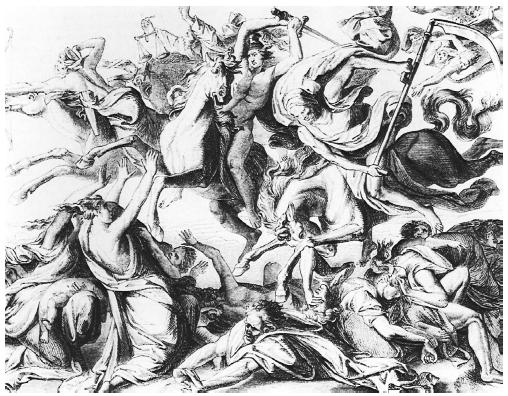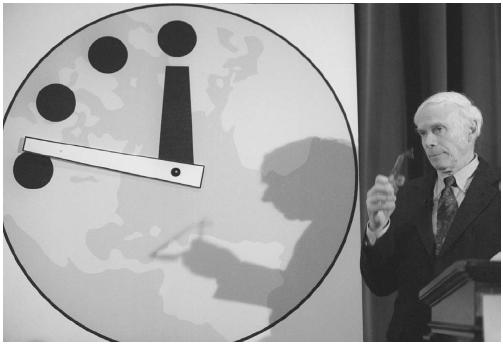APOCALYPSE
In apocalyptic visions, prophets see ahead to the end time. Humankind's salvation lies in the future, and the meaning of the present is obscured in the chaos of survival on the Earth's plane. In apocalyptic thought, humankind's destiny is viewed as steadily unfolding according to a great design of God. The present is a time of trial and tribulation, and its meaning will only be made clear in the last days before the final judgment occurs. Placing the ultimate revelation of God at the end time seems to imply a history for God, as well as for his creation—or at least an evolution, or transformation, from one sphere of activity to another.
In the Jewish tradition, apocalyptic thought presupposes a universal history in which the Divine Author of that history will reveal and manifest his secrets in a dramatic end time that with finality will establish the God of Israel as the one true God. The "end of days" (acharit ha-yamin) is bound up with the coming of the Messiah, but before his appearance governments will become increasingly corrupt, religious schools will become heretical, the wisdom of the scribes and teachers will become blasphemous, young people will shame their elders, and members of families will turn upon one another. Then, just prior to the arrival of the Messiah, the righteous of Israel shall defeat the armies of evil that have gathered under the banner of Gog and Magog, and the exiles shall return to the Holy Land. The world will be at peace and all people will recognize the one true God. With the advent of the Messiah will come the great Day of Judgment in which the dead shall rise from their graves to begin a new life. During the period known as the World to Come (Olam Haba), the righteous will join the Messiah in partaking of a great banquet in which all foods, even those previously judged impure, shall be declared kosher. All the many nations of the world will communicate in one language; the Angel of Death will be slain by God; trees and crops will produce fresh harvests each month; the warmth of the sun shall heal the sick; and the righteous will be nourished forever by the radiance of God.
To most orthodox Christians, the profound meaning of the New Testament is that Jesus Christ (c. 6 B.C.E.–c. 30 C.E.) will one day return in the Last Days and his Second Coming will prompt the resurrection of the dead and the Final Judgment. The heart of the gospels is eschatological, or end-oriented. The essential theme of Jesus and the apostles is that the last stage of history, the end time, was being entered into with his appearance. In Matthew 24:3–44, Jesus speaks to his disciples at great length concerning false Messiahs and prophets who will deceive many people with their rumors about the end of the world. He makes reference to the prophet Daniel and his warnings concerning the end times and the Antichrist, and he admonishes the disciples not to chase after false teachers who will produce great miracles and signs to trick God's chosen ones. No one knows when the Son of Man shall appear again coming on the clouds of heaven, Jesus tells them, not even the angels.
As in Jewish apocalyptic tradition, Christians also recognize that there must come the terrible time when the Antichrist, summoning great powers of evil, will triumph for a period over the righteous believers and that there will be one last awful clash between the forces of good under the banner of Christ and his angels and the minions of evil under the banner of Satan. Before that final battle in the valley of Armageddon, the faithful may look for various signs to alert them that the end time, the Apocalypse, has begun. Drawing upon the apocalyptic traditions of his Jewish background, John the Revelator, presents in Revelation, the last book in the New Testament, a guidebook for the Christian on what to expect during the Apocalypse, the time of Tribulation. Specifically, the book was written for the members of the churches of Ephesus, Smyrna, Pergamum, Thyatira, Sardis, Philadelphia, and Laodicea in order to prepare them for what John believed to be a fast-approaching time of persecution and the return of Jesus Christ.
The first of Seven Seals to be opened (Revelation 6:1–2) by the Lamb (Christ) discloses a conquering king astride a white horse, the first of the Four Horsemen of the Apocalypse. Scholars disagree whether this triumphant king represents Christ returning to do battle with Satan or the Antichrist emerging to summon the forces of evil to oppose Christ and his angelic army. The Second Seal (6:3–4) reveals the red horse, representing civil war; the third, the black horse, symbolizing famine (6:5–6); the fourth, the pale horse, representing the suffering that follows war and famine. The Fifth Seal to be opened by the Lamb yields a vision of the persecution of the

But rising out of the abyss to block Christ's triumph at Armageddon is a monstrous army of demons, some resembling locusts and scorpions, others a repulsive mixture of humans, horses, and lions. These demons are soon joined by 200,000 serpentine-leonine horsemen capable of belching fire, smoke, and brimstone. Led by Satan, the once-trusted angel who led the rebellion against God in Heaven, the Prince of the World sets his legions upon the faithful to make their lives as miserable as possible in the end time. To make matters even more complex for those who serve God, the Antichrist appears on the scene pretending to be the Lamb, the Messiah. John the Revelator is told that this man, this beast in lamb's clothing, can be recognized by a name, the letters of which, when regarded as numbers, total 666.

Although the term "Antichrist" is frequently used by those Christians who adhere to the New Testament book of Revelation as a literal guide to the end of days which they feel is here, the word is nowhere to be found within its text. Traditionally, it was believed for many centuries that the apostle John, the one especially loved by Jesus, was the author of Revelation. Contemporary scholarship generally disputes that St. John was the lonely visionary on the Island of Patmos who foresaw the time of great tribulation. It is, however, likely that the apostle John is the first to mention the Antichrist. In 1 John 2:18, he declares that the "enemy of Christ" has manifested and that many false teachers have infiltrated the Christian ranks. In verse 22, John names as the Antichrist anyone who would deny Jesus as the Christ and the Father and the Son as the Antichrist, and in 2 John verse 7 he declares that there are many deceivers already at work among the faithful.
According to Revelation, Christ and his angelic armies of light destroy the forces of darkness at Armageddon in the final battle of good versus evil. Babylon, the False Prophet, and the Beast (the Antichrist) are dispatched to their doom, and Satan, the Dragon, is bound in a pit for a thousand years. With Satan imprisoned and chained, the Millennium, the Thousand Years of peace and harmony, begins.
Although Christ's Second Coming is said to be mentioned over 300 times in the New Testament, the only references to the Millennium are found in Revelation 20:2–7. Christian scholars disagree whether or not there will be an initial resurrection of the just at the advent of the Millennium and a second one a

For some rather incomprehensible reason, Satan is released from the pit at the conclusion of the Millennium; and true to his nature, he makes a furious attempt to regain his earthly kingdom. His former allies, the Beast (the Antichrist), the False Prophet, and the hordes of Babylon, were destroyed at Armageddon, but there were some demons who escaped annihilation at the great battle who stand ready to serve their master. In addition to these evil creatures, Satan summons Gog and his armies of the Magog nations to join them in attacking the saints and the righteous followers of God. Although the vast multitude of vile and wicked servants of evil and grotesque monsters quickly surround the godly men and women, God's patience with the rebellious angel has come to an end. Fire blasts down from heaven, engulfing and destroying the satanic legions and the armies of Gog and Magog. Satan himself is sent to spend the rest of eternity in a lake of fire.
And now (Revelation 20:11–15) comes the Final Judgment, the time when God shall judge the secrets of all men and women (Romans 2:16). This Judgment will be complete. Every person from every age and nation will be there. And there shall only be classes: the Saved and the Lost. The Book of Life will have the names of the Saved. For those whose names do not appear on those heavenly records, there is the final doom: to be sentenced to join Satan and his angels in the place where the fire is never quenched. When the Judgment has been completed, the first heaven and Earth shall pass away and a new heaven and new Earth shall be established for those Saved to occupy with their glorified, incorruptible, spiritual bodies.
DELVING DEEPER
Abanes, Richard. End-Time Visions. Nashville, Tenn.: Broadman & Holman, 1998.
Cohn, Norman. The Pursuit of the Millennium. New York: Oxford University Press, 1970.
Goetz, William R. Apocalypse Next. Camp Hill, Penn.: Horizon Books, 1996.
Shaw, Eva. Eve of Destruction: Prophecies, Theories and Preparations for the End of the World. Chicago: Contemporary Books, 1995.
Unterman, Alan. Dictionary of Jewish Lore and Legend. New York: Thames and Hudson, 1991.
Wheeler, John Jr. Earth's Two-Minute Warning: Today's Bible-Predicted Signs of the End Times. North Canton, Ohio: Leader Co., 1996.

Comment about this article, ask questions, or add new information about this topic: